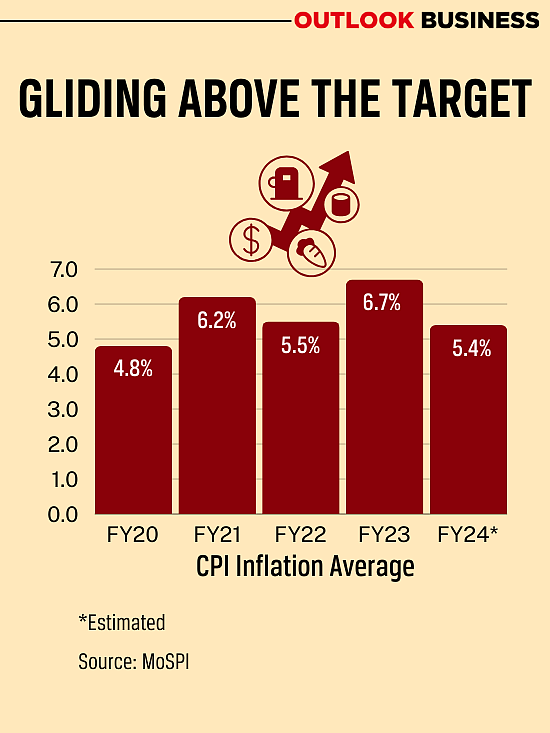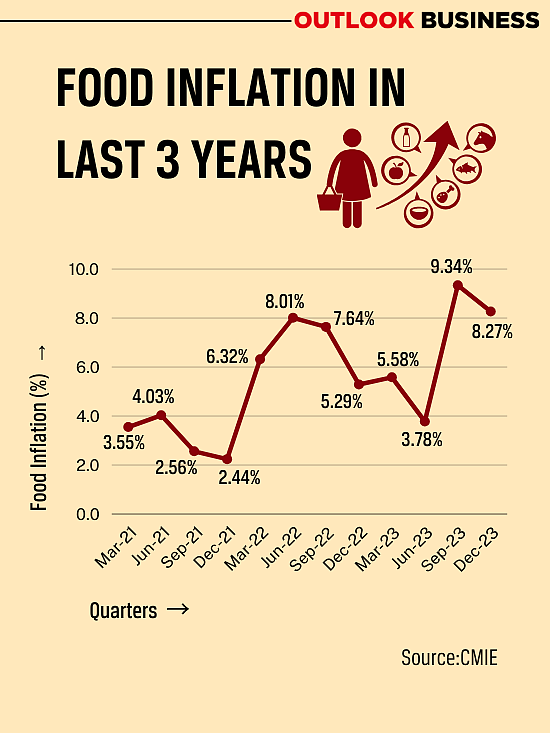Shaktikanta Das, the Governor of the Reserve Bank of India (RBI), had made it clear — India’s central bank wants the country’s inflation number at 4 per cent. “I would like to emphatically reiterate that our inflation target is 4 per cent and not 2–6 per cent,” Das had said at a press conference after the bank’s monetary policy committee (MPC) meeting in October 2023.
Four months later, in February 2024, the RBI, in a bulletin, said monetary policy amid lingering uncertainties such as recurrent food price shocks and geopolitical tensions must remain vigilant to ensure that India successfully navigates the last mile of disinflation.
Advertisement
In 2023-24, India’s headline inflation remained high and volatile, moving in a range of 4.3 per cent to 7.4 per cent. This is while the country’s gross domestic product (GDP) recorded an average growth of 8.2 per cent in three quarters of FY2024. To sustain this growth, it is imperative that inflation comes down to 4 per cent or lower.

This is because a 1 per cent decrease in inflation leads to a 64 basis points increase in GDP growth, says Devendra Kumar Pant, chief economist at India Ratings & Research. “A 1 per cent increase in real wages will lead to a 112 basis points increase in consumption growth, which in turn will lead to a 64 basis points increase in GDP growth.” India can achieve 1 percentage point higher real wages just by bringing down retail inflation by 1 per cent, he says.
Advertisement
India’s core inflation, a figure that excludes volatile components such as food and fuel, has been below 4 per cent since December, and is expected to remain stable in the coming months. But what is tripping attempts to rein in inflation is food.
Food inflation in February rose to 8.6 per cent from 8.3 per cent in January. The rise was attributed to high inflation on essentials such as tomatoes, potatoes, milk, chicken, eggs and fish. Prices of ‘cereals and products’ saw an inflation of 7.6 per cent, of 'meat and fish' 5.2 per cent and 'milk and products' 3.86 per cent.
Arresting inflation in food products is difficult for the government. “We are now in a situation where the government’s ability to intervene is limited,” says former chief statistician Pronab Sen. According to Sen, the government can only intervene in rice, wheat, some pulses and oil. “When your food basket has shifted to things like vegetables, meat and dairy products, the government has no ability to intervene.”
Vegetables are perishable, with shelf lives lasting days, making it difficult to regulate prices. Production and distribution of meat and dairy involve a complex web of factors that include animal husbandry, transportation and storage, all processes that are usually decentralised. The food distribution chain requires significant improvement, says Sen.
Advertisement

It was mainly due to the government’s efforts that CPI inflation came down from a 15-month high last year. In July last year, retail inflation had surged to 7.44 per cent due to an abnormal rise in the price of vegetables due to scarce rainfall in parts of the country that farms vegetables.
The government started selling onions and tomatoes at retail outlets and mobile vans to temper the prices. Inflation came down to 6.83 per cent. Since then, it has been on the decline, but the target of 4 per cent still seems out of reach.
“Occasional volatility in CPI driven by food commodities cannot be ruled out in the current financial year, especially given greater uncertainty in weather conditions in recent years,” says Siddhartha Sanyal, chief economist at Bandhan Bank.
Advertisement
In February, India’s retail inflation based on the consumer price index (CPI) was at 5.09 per cent. Economists expect retail inflation in March to be between 5.1 and 5.2 per cent, with it going down to around 4.5 per cent in the 2024–25 financial year.
Assuming a typical monsoon this year, the central bank has projected CPI inflation at 4.5 per cent for 2024–25, 5 per cent in the first quarter, 4 per cent in the second, 4.6 per cent in the third and 4.7 per cent in the fourth. “The inflation trajectory going forward would be shaped by the outlook on food inflation, about which there is considerable uncertainty,” Governor Das had said in February.
Advertisement
Getting a handle on inflation is crucial to ensure some degree of stability in prices of goods and services. Economists say the stability will encourage consumption and demand in the country, which can help India sustain the current growth momentum. Private sector investment is down due to low demand, which may get a fillip if inflation is checked. “Stable and low inflation at 4 per cent will provide the necessary bedrock for sustainable economic growth,” the RBI had said in February.
Also Read | Why India's Growth Story Is A House Of Cards
















 Just one email a week
Just one email a week